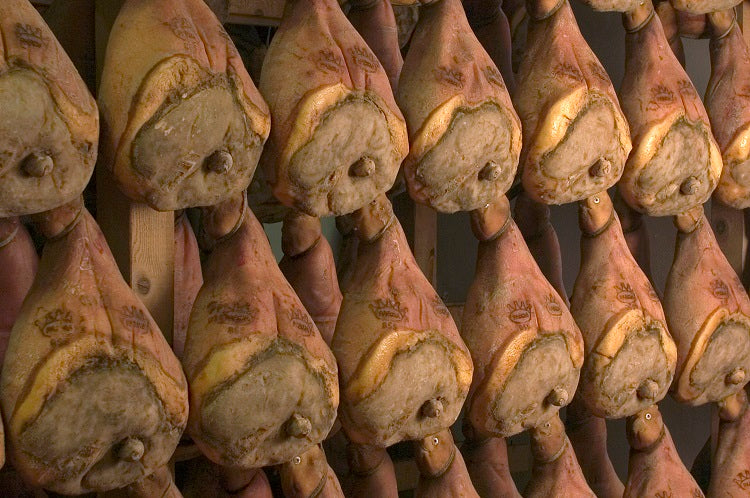
At Eataly, we love prosciutto. Each impossibly thin slice of cured pork packs an abundance of salty and satisfying flavour that varies depending on how (and where) it's made. After visiting different
prosciuttifici across Italy, our buyers chose to offer Prosciutto di Parma DOP in our markets.
Learn more about this salumi with our guide below!
WHAT IS PROSCIUTTO DI PARMA?
Like many Italian foods, all prosciutto does not taste the same, thanks to regional biodiversity and culinary customs. Prosciutto di Parma is a specific variety of cured pork made according to certain traditions.
In Parma, a town in the heart of Emilia-Romagna, making prosciutto is part of an age-old tradition passed on from generation to generation. In fact, Prosciutto di Parma dates back thousands of years to Roman times, when, in 100 BCE, Cato the “Censor” first mentioned the extraordinary taste of the air-cured ham made around the town of Parma, Italy. In order to make their prized meat last longer, villagers would hang it up to dry, covering it in salt and oil to prevent spoilage.
HOW IS PROSCIUTTO DI PARMA MADE?
To make this variety of prosciutto, producers must follow strict legal guidelines which are closely monitored by the
Consorzio di Prosciutto di Parma. The time-honoured methods are 100% natural: no additives, just sea salt, air, and time.
PORK
Prosciutto di Parma can only be produced from the hind legs of specially-selected heritage breed pigs raised in the 11 approved regions of Italy. Left to freely roam the farms, the pigs are fed a wholesome diet of natural forage and leftover whey from the production of Parmigiano Reggiano. This unique diet imparts a sweet and nutty flavour on the meat.
SALT
The legs are salted by hand by a
maestro salatore, or "salt master," then left to rest at cool temperatures for one week. After that, the meat is salted a second time and left to set for another two weeks. Next. the salted pork is hung in refrigerated, humidity-controlled rooms between 60 to 90 days. This ensures that the meat properly absorbs the salt. After the proper amount of time, the hams are washed and brushed before moving on to the curing process.


 TIME
TIME
Once dry, the legs are hung on wooden frames in well-ventilated rooms, with natural breezes from the outside. The ageing of the pork may only be done in a controlled zone around Parma, in particular, the area of Langhirano. Here the air is dry with aromatic breezes from the surrounding Apennine mountains, which is why Prosciutto di Parma tastes different from other types of cured ham!
FAT
After the initial curing, the legs are smeared with a mixture of lard, salt, and pepper to help the meat from drying out too quickly. They are then hung back up in dark cellars and cured for at least 14 months, although some producers may age them as long as 36 months.
INSPECTION
After the right amount of time has passed, a knowledgeable inspector pierces the jam with a thin needle. He or she will smell each puncture to check for aromas that may indicate a flaw. If the prosciutto passes the test, it is branded with a special symbol: a five-point "Ducal Crown" with the word "Parma" written inside. This symbol is how you know if the Prosciutto di Parma is guaranteed authentic!
To learn more about how its made, visit the
Consorzio di Prosciutto di Parma DOP website!
WHAT DOES PROSCIUTTO DI PARMA TASTE LIKE?
Called the "King of Hams," the resulting Prosciutto di Parma yields delicate, sweet flavours in every bite. Excellent on its own, Prosciutto di Parma pairs well with rustic bread, juicy melon, and creamy mozzarella. Check out our pairing guide for ideas on how to serve the savoury product.
 Ready to try Prosciutto di Parma? Taste and pair it for yourself at Eataly Toronto!
Ready to try Prosciutto di Parma? Taste and pair it for yourself at Eataly Toronto!
 At Eataly, we love prosciutto. Each impossibly thin slice of cured pork packs an abundance of salty and satisfying flavour that varies depending on how (and where) it's made. After visiting different prosciuttifici across Italy, our buyers chose to offer Prosciutto di Parma DOP in our markets.
Learn more about this salumi with our guide below!
At Eataly, we love prosciutto. Each impossibly thin slice of cured pork packs an abundance of salty and satisfying flavour that varies depending on how (and where) it's made. After visiting different prosciuttifici across Italy, our buyers chose to offer Prosciutto di Parma DOP in our markets.
Learn more about this salumi with our guide below!


 TIME
Once dry, the legs are hung on wooden frames in well-ventilated rooms, with natural breezes from the outside. The ageing of the pork may only be done in a controlled zone around Parma, in particular, the area of Langhirano. Here the air is dry with aromatic breezes from the surrounding Apennine mountains, which is why Prosciutto di Parma tastes different from other types of cured ham!
FAT
After the initial curing, the legs are smeared with a mixture of lard, salt, and pepper to help the meat from drying out too quickly. They are then hung back up in dark cellars and cured for at least 14 months, although some producers may age them as long as 36 months.
INSPECTION
After the right amount of time has passed, a knowledgeable inspector pierces the jam with a thin needle. He or she will smell each puncture to check for aromas that may indicate a flaw. If the prosciutto passes the test, it is branded with a special symbol: a five-point "Ducal Crown" with the word "Parma" written inside. This symbol is how you know if the Prosciutto di Parma is guaranteed authentic!
To learn more about how its made, visit the Consorzio di Prosciutto di Parma DOP website!
TIME
Once dry, the legs are hung on wooden frames in well-ventilated rooms, with natural breezes from the outside. The ageing of the pork may only be done in a controlled zone around Parma, in particular, the area of Langhirano. Here the air is dry with aromatic breezes from the surrounding Apennine mountains, which is why Prosciutto di Parma tastes different from other types of cured ham!
FAT
After the initial curing, the legs are smeared with a mixture of lard, salt, and pepper to help the meat from drying out too quickly. They are then hung back up in dark cellars and cured for at least 14 months, although some producers may age them as long as 36 months.
INSPECTION
After the right amount of time has passed, a knowledgeable inspector pierces the jam with a thin needle. He or she will smell each puncture to check for aromas that may indicate a flaw. If the prosciutto passes the test, it is branded with a special symbol: a five-point "Ducal Crown" with the word "Parma" written inside. This symbol is how you know if the Prosciutto di Parma is guaranteed authentic!
To learn more about how its made, visit the Consorzio di Prosciutto di Parma DOP website!
 Ready to try Prosciutto di Parma? Taste and pair it for yourself at Eataly Toronto!
Ready to try Prosciutto di Parma? Taste and pair it for yourself at Eataly Toronto!

